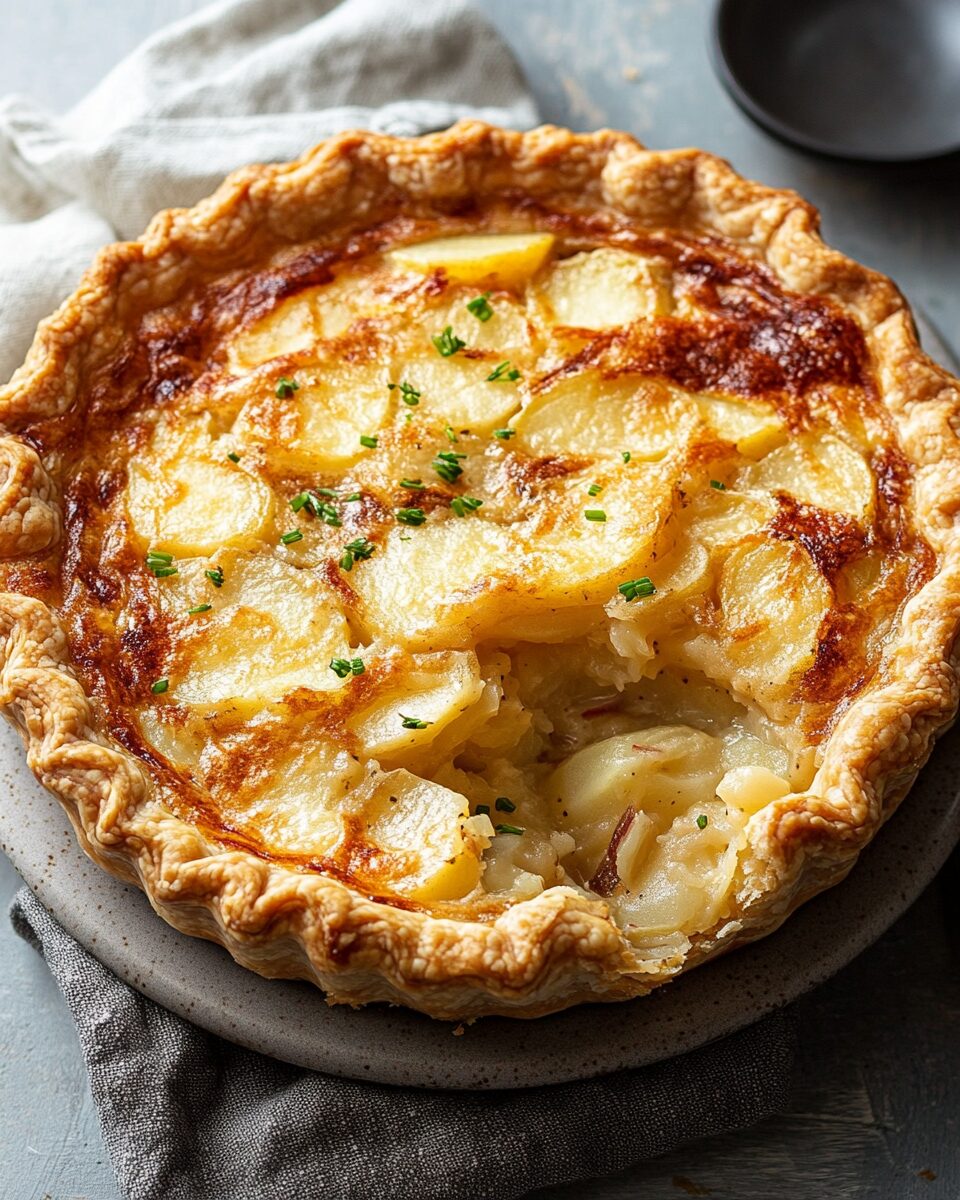The Traditional Irish Potato Pie is a heartwarming dish that combines simple ingredients into a rich, flavorful, and satisfying meal. With layers of tender potatoes, sharp Irish cheddar, and a perfectly flaky crust, this pie is a must-try for those who love comfort food with a bit of a rustic touch.
This savory pie is a great addition to any meal, whether as a main course served with a fresh salad or as a side dish for a hearty dinner. The combination of buttery crust and creamy potatoes is simply irresistible, making it an ideal recipe for cozy family gatherings or special occasions.
Full Recipe
Ingredients:
- 4 large russet potatoes, peeled and thinly sliced
- 1 refrigerated pie crust (or homemade)
- 1 cup shredded Irish cheddar cheese
- ½ cup heavy cream
- 2 tablespoons unsalted butter, melted
- 1 teaspoon salt
- ½ teaspoon black pepper
- ½ teaspoon dried thyme
- ½ teaspoon garlic powder
- 1 egg, beaten (for egg wash)
- Fresh parsley, chopped (for garnish)
Directions:
- Preheat oven to 375°F (190°C). Grease a 9-inch pie dish.
- Roll out the pie crust and press it into the pie dish, trimming any excess.
- Layer half of the thinly sliced potatoes into the crust. Sprinkle with half of the salt, pepper, thyme, and garlic powder.
- Sprinkle half of the shredded cheddar cheese over the potatoes.
- Repeat the layers with the remaining potatoes, seasonings, and cheese.
- Drizzle heavy cream over the entire pie, then brush melted butter over the top.
- Brush the crust edges with the beaten egg for a golden finish.
- Cover the pie loosely with aluminum foil and bake for 40 minutes.
- Remove the foil and bake for an additional 20-25 minutes, until golden brown and bubbly.
- Allow to cool slightly before garnishing with fresh parsley and serving.
Prep Time: 20 minutes | Cooking Time: 60 minutes | Total Time: 1 hour 20 minutes
Kcal: 380 kcal | Servings: 6 servings
Introduction to Traditional Irish Potato Pie
Traditional Irish Potato Pie is a dish deeply rooted in Irish culture and history. It is a simple yet hearty meal that has been a staple in Irish households for centuries. This pie combines basic yet flavorful ingredients such as potatoes, cheese, and a flaky crust, making it an affordable, satisfying, and comforting dish. Irish cuisine has long been known for its reliance on potatoes, which became a staple in the country’s diet after their introduction in the 16th century. This pie is a testament to the ingenuity of Irish cooks who transformed humble ingredients into a delicious and nourishing meal.
The History and Significance of Irish Potato Pie
Potatoes have played an essential role in Ireland’s history, especially during the 18th and 19th centuries when they became a primary food source for the majority of the population. The reliance on potatoes led to the development of various potato-based recipes, including Irish Potato Pie. This dish was traditionally prepared by families who needed to create filling and affordable meals using ingredients they had readily available.
Irish Potato Pie was often served as a standalone dish or as a side to complement meats and stews. It was a favorite among farmers and laborers who needed high-energy meals to sustain them throughout the day. Over time, the recipe has evolved, incorporating different types of cheese, seasonings, and sometimes even meats like bacon or sausage for extra flavor. Today, it remains a cherished part of Irish cuisine, often prepared for family gatherings and celebrations.
The Unique Characteristics of Irish Potato Pie
One of the key characteristics of Irish Potato Pie is its simplicity. The dish relies on a handful of basic ingredients that come together to create a rich, creamy, and savory pie. The star ingredient, potatoes, provides a soft and fluffy texture, while Irish cheddar cheese adds a sharp and tangy flavor. The pie crust, whether homemade or store-bought, serves as the perfect buttery and flaky base that holds everything together.
The addition of heavy cream enhances the richness of the pie, while seasonings like thyme, garlic, and black pepper elevate its taste. This pie is typically baked until the crust is golden brown and the filling is bubbling with melted cheese, creating an irresistible aroma that fills the kitchen.
Variations of Irish Potato Pie
While the traditional version of this pie remains a favorite, many variations have emerged over the years to cater to different tastes and dietary preferences. Some popular variations include:
- Bacon and Potato Pie: Adding crispy bacon bits to the filling enhances the flavor and provides a smoky depth to the dish.
- Vegetarian Potato Pie: Some versions replace cheese with dairy-free alternatives and include vegetables like onions, leeks, and mushrooms.
- Spiced Potato Pie: Incorporating spices such as paprika, nutmeg, or cayenne pepper can give the pie a unique twist.
- Meaty Potato Pie: Ground beef, sausage, or shredded chicken can be added to make the pie a heartier main dish.
- Shepherd’s Style Potato Pie: This version incorporates a layer of mashed potatoes on top rather than sliced potatoes, resembling a shepherd’s pie.
These variations allow for creativity in the kitchen and make the recipe adaptable to different occasions and preferences.
Reasons to Make This Dish
Irish Potato Pie is not only delicious but also practical and versatile. Here are some reasons why you should consider making this dish:
- Comfort Food Appeal: This pie is warm, creamy, and full of comforting flavors, making it perfect for cozy meals during colder months.
- Budget-Friendly: The ingredients used in this recipe are affordable and easily accessible, making it a great option for families on a budget.
- Easy to Make: Even beginner cooks can prepare this dish with ease, as it requires simple techniques and minimal effort.
- Customizable: The recipe can be adapted to include different flavors, add-ins, or dietary modifications to suit individual preferences.
- Perfect for Gatherings: Whether served as a main dish or a side, this pie is sure to impress guests at family dinners, potlucks, or festive occasions.
Serving Suggestions and Pairings
Irish Potato Pie is a versatile dish that pairs well with a variety of accompaniments. Some serving suggestions include:
- With a Side Salad: A fresh green salad with vinaigrette dressing balances the richness of the pie.
- Alongside Soup: A bowl of tomato soup or Irish leek and potato soup makes for a comforting meal.
- With Roasted Vegetables: Roasted carrots, Brussels sprouts, or parsnips complement the flavors of the pie.
- With Irish Soda Bread: A slice of warm Irish soda bread completes the meal with its hearty texture.
- With a Light Protein: If serving as a side dish, it pairs well with grilled chicken, roasted lamb, or baked fish.
Storage and Reheating Tips
Irish Potato Pie can be made ahead of time and stored for later use. Here are some tips on how to store and reheat leftovers:
- Refrigeration: Store any leftovers in an airtight container in the refrigerator for up to 3 days.
- Freezing: To freeze, wrap the pie tightly in plastic wrap and aluminum foil. It can be stored in the freezer for up to 2 months.
- Reheating: To reheat, place the pie in a preheated oven at 350°F (175°C) for about 15-20 minutes until heated through. You can also reheat individual slices in the microwave for a quicker option.
Conclusion
Traditional Irish Potato Pie is a beloved dish that showcases the heart and soul of Irish cuisine. With its simple ingredients, rich flavors, and comforting texture, it is a recipe that has stood the test of time. Whether you stick to the classic version or experiment with variations, this pie is a delightful addition to any meal. Its versatility, affordability, and ease of preparation make it a must-try for home cooks looking for a satisfying dish that brings warmth and nostalgia to the table. If you haven’t yet tried this delicious pie, now is the perfect time to give it a go and enjoy a taste of Ireland’s culinary heritage.






